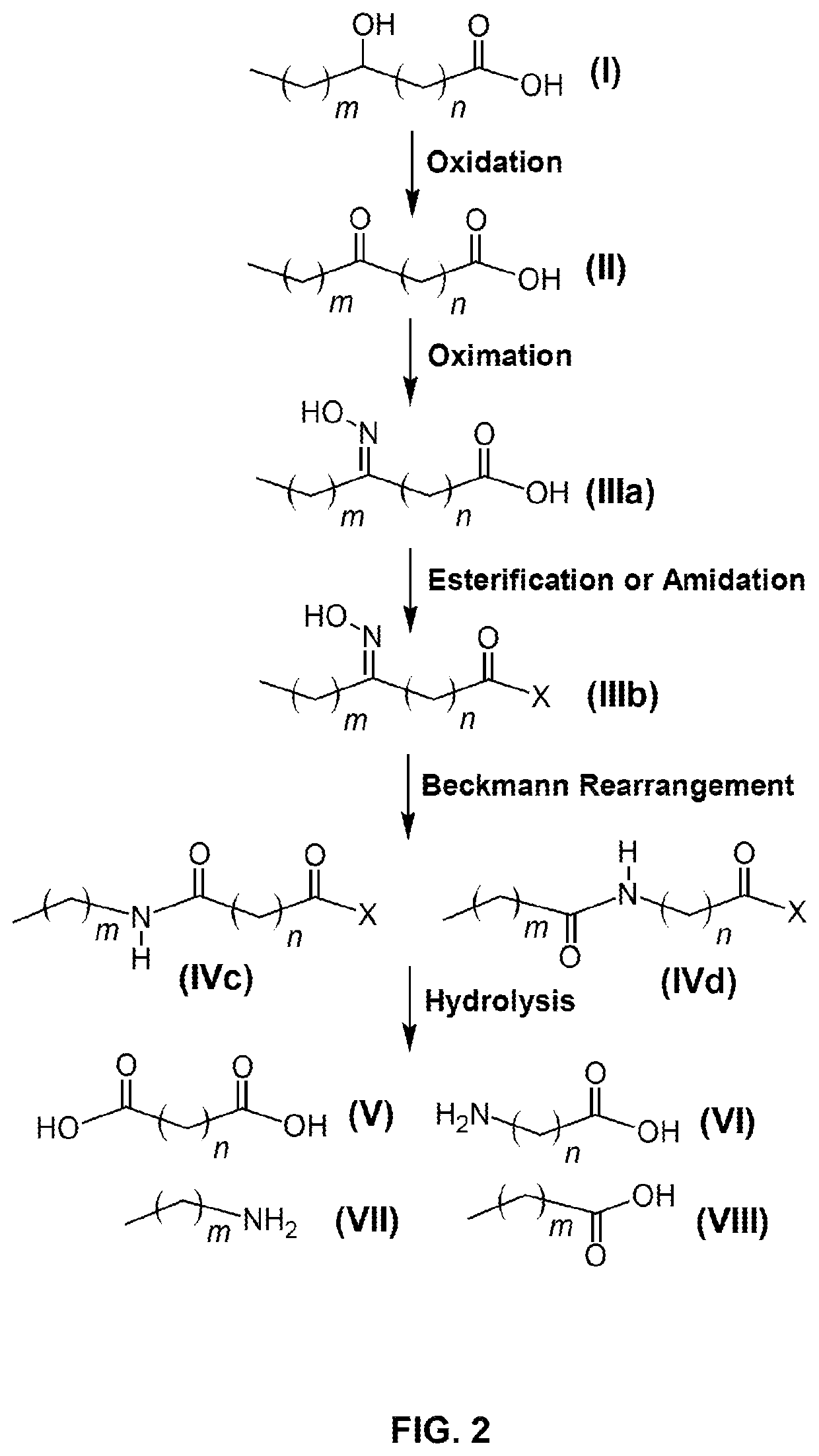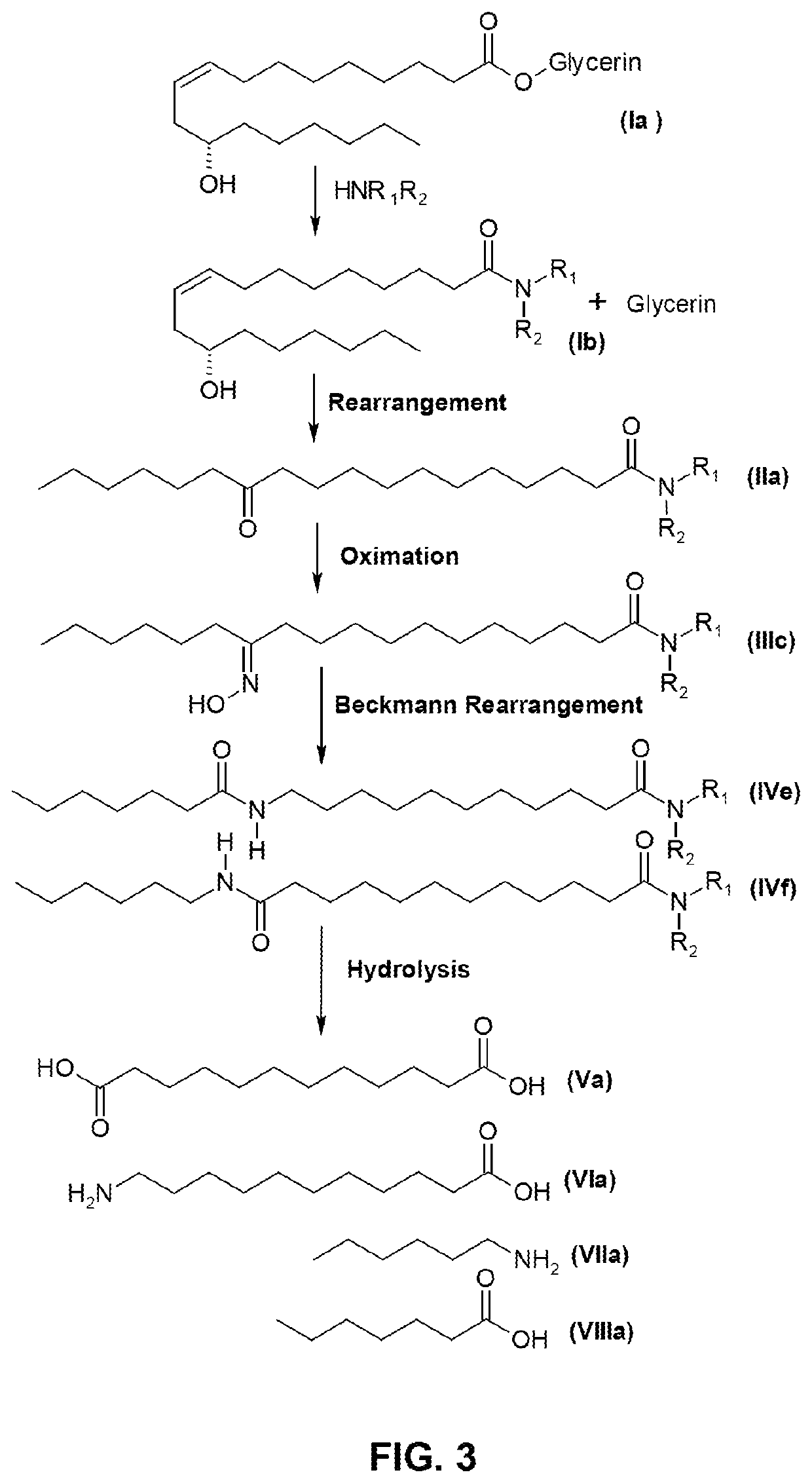Process for producing long chain amino acids and dibasic acids
a technology of dibasic acid and long chain amino acids, which is applied in the preparation of amino compounds, carboxylic acid amide preparations, organic chemistry, etc., can solve the problems of requiring a very corrosive alkaline scission of castor oil, affecting the production efficiency and affecting the quality of long chain nylon monomers
- Summary
- Abstract
- Description
- Claims
- Application Information
AI Technical Summary
Benefits of technology
Problems solved by technology
Method used
Image
Examples
example 1
[0136]This example relates to the production of 11-aminoundecanoic acid and dodecanedioic acid.
[0137]90 g of 12-ketostearic acid was mixed with 200 mL of water, followed by an aqueous solution of hydroxylamine sulfate (about 8%) containing 14.5 g of hydroxylamine. The mixture was vigorously stirred at 70-85° C., while the pH of the solution was adjusted to 4.5 to 5.0 with aqueous ammonia. After reacting for 2 hours, the starting material was completely transformed to 12-oxime stearic acid as indicated by HPLC analysis.
[0138]After the oximation reaction was complete, the mixture was settled to separate off aqueous phase and the upper oil phase was dried under vacuum. The product was dissolved in 500 mL of 98% methanesulfonic acid and heated to 140° C. for 4 hours to complete the Beckmann rearrangement. The reaction was terminated by adding 500 mL of water. The product of mixed amide fatty acids of reddish color was obtained after filtration and washing with deionized water.
[0139]The ...
example 2
[0144]This example relates to the production of 9-aminononanoic acid and sebacic acid.
[0145]90 g of 10-ketostearic acid was mixed with 200 mL of water, followed by an aqueous solution of hydroxylamine sulfate (about 8%) containing 12.5 g of hydroxylamine. The mixture was vigorously stirred for 2 hours at 70-80° C., while the pH of the solution was adjusted to 4.5 to 5.0 with aqueous ammonia. HPLC analysis indicated that the starting material was completely transformed to 10-oxime stearic acid.
[0146]After aqueous phase was separated off, the oil phase was dried under vacuum and dissolved in a mixture of 100 g of trifluoroacetic acid and 100 g of acetonitrile. The solution was refluxed for 8 hours to complete the Beckmann rearrangement. After distilling off solvent, 300 mL of water was added to precipitate the product of the mixed amide fatty acids of an off-white color.
[0147]The solid material of mixed amide fatty acids was dissolved in 200 mL of acetic acid, followed by 200 mL of 30...
example 3
[0151]This example relates to the production of 13-aminotridecanoic acid and brassylic acid.
[0152]100 g of 14-ketoarachidic acid was mixed with 200 mL of water, followed by an aqueous solution of hydroxylamine sulfate (about 8%) containing 16.5 g of hydroxylamine. The mixture was vigorously stirred for 2 hours at 75-85° C., while the pH of the solution is adjusted to 4.5 to 5.0 with aqueous ammonia. HPLC analysis indicated that the starting material was completely transformed to 14-oxime arachidic acid.
[0153]After aqueous phase was separated off, the oil phase was dried in vacuum. The residual waxy solid was slowly added to 300 mL of 98% sulfuric acid at 100° C. The solution was stirred at the same temperature for 2 hours to complete the Beckmann rearrangement, which was terminated by adding 800 g of ice. The product of the mixed amide fatty acids of dark color was obtained by filtration and washing with water.
[0154]The solid material was dissolved in 700 mL of 8% sodium hydroxide, ...
PUM
| Property | Measurement | Unit |
|---|---|---|
| temperature | aaaaa | aaaaa |
| temperature | aaaaa | aaaaa |
| temperature | aaaaa | aaaaa |
Abstract
Description
Claims
Application Information
 Login to View More
Login to View More - R&D
- Intellectual Property
- Life Sciences
- Materials
- Tech Scout
- Unparalleled Data Quality
- Higher Quality Content
- 60% Fewer Hallucinations
Browse by: Latest US Patents, China's latest patents, Technical Efficacy Thesaurus, Application Domain, Technology Topic, Popular Technical Reports.
© 2025 PatSnap. All rights reserved.Legal|Privacy policy|Modern Slavery Act Transparency Statement|Sitemap|About US| Contact US: help@patsnap.com



